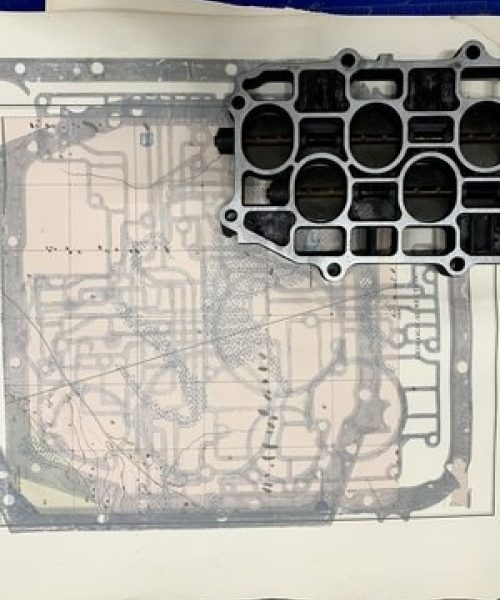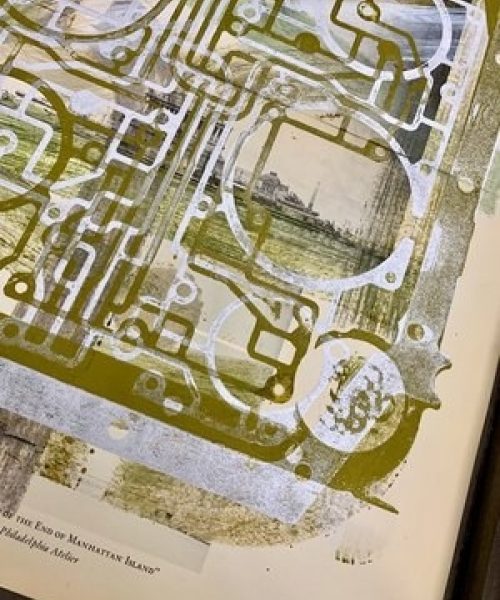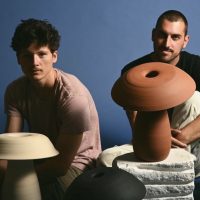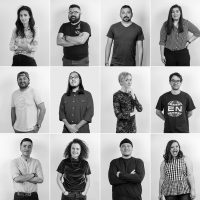Explore the exhibition
Join host Susan Merritt as she helps us to discover the unparalleled Athenaeum School of the Arts Print Studio, which opened in 2016 and is dedicated to teaching letterpress and printmaking.
View work demonstrating a range of printmaking techniques from relief printing with letterpress and woodcut to intaglio and one-of-a-kind monoprints produced by students, including several design professionals eager to get back to the hand craft of typography and experiment with traditional and non-traditional print production.
Meet book artist Sibyl Rubottom, manager of the Print Studio, who also teaches book arts and printmaking classes along with Illustrator Morgan Miller III. Learn more through the design article, then take a peek inside the studio during a video walk-through with Rubottom to catch a glimpse of the classic presses and type cases that contain an assortment of metal and wood type.

VIDEO: SIBYL RUBOTTOM AT ATHENAEUM PRINT STUDIO
*Note: This event pairs well with Film screening: Graphic Means, Learn All Things Letterpress, and Design History at Your Fingertips.
A Place Where Letterpress and Printmaking Press On
Athenaeum School of the Arts Print Studio at the Athenaeum Art Center, a branch of the Athenaeum Music & Arts Library
by Susan Merritt
I was first introduced to typography and letterpress printing when I was a 22-year-old postgraduate student at the Basel School of Design. Typography was a required class taught by Wolfgang Weingart in the school’s well-equipped type shop that graphic design students shared with the typesetting apprenticeship program. Typecases packed with lead type in a range of point sizes filled the room while a row of manual letterpress printers stood at the ready. There was also a bindery. This experience, together with André Gürtler’s Letterform Design classes, instilled in me an appreciation for the letters of the Roman alphabet, a good taste for type, and a passion for the printed page. The scope of my professional work as a graphic designer, design educator, and book artist, as well as my research and writing, often lean toward typography and printing.
I embraced the challenge of adapting to the Macintosh enthusiastically at first but after ten years I yearned to get back to the hand craft that had welcomed me into graphic design in the first place. So, I enrolled in book arts classes taught by book artist Genie Shenk in the cozy printmaking studio at Mesa College. That’s where I met Sibyl Rubottom who manages the Athenaeum Art Center’s Print Studio. During the summer months, I attended Paper & Book Intensive (PBI) workshops around the country and joined printmaking and book arts sessions in Maine at the amazing Haystack Mountain School of Crafts, and for a while I was a member of Bay Park Press formerly run by Sibyl and printmaker Jim Machacek. In 2003, I was awarded a month-long residency at the Hamilton Wood Type and Printing Museum, which claims the worldʼs largest archive of wood type. While in residence, I had such fun experimenting with their collection of decorative wood borders and corners and their extensive assortment of type styles and sizes from 6-point to 16 inches! It was like being 22 again.
You can see why I was looking forward to once again turning back the clock and setting type and printing broadsides throughout the summer of 2020 at the Print Studio together with my friend Patricia Cué, who also serves on the San Diego Design Week steering committee. Our plan was to organize an exhibition in the gallery at the Athenaeum Art Center together with Sibyl and during San Diego Design Week showcase work produced at the Print Studio.
Then the pandemic swept us all into quarantine.
So, I’m writing about the Print Studio instead. I hope these interviews with Sibyl and a few of her students and a glimpse at some of their work will suffice until we can once again gather in person at the Athenaeum Art Center.
Interviews
Sibyl Rubottom
Book artist, teacher, manager of the Print Studio
SM: How did you get involved in printmaking?
Sibyl: When I was in college at the Rhode Island School of Design, I took printmaking with Michael Mazur, a wonderful printmaker and teacher. But I didn’t come back to printmaking until I started making artist books. I studied book arts with Genie Shenk at Mesa College where they had a Challenge Press and moveable type. Jim Machacek, the printmaking teacher at Mesa, helped me print my first letterpress book, The First Quarter, a book of four poems by my son Otis in celebration of his 25th birthday and completion of his master’s degree in writing from New York University.
SM: What was it about book arts that grabbed your attention?
Sibyl: When I first discovered the world of artist books I felt like I had found my home. All the things I had been studying and working with in my art—text, structure, and image—came together. My skills in various media, like painting, printmaking, fabric, and my collections of various ephemera converged. And I fell in love with letterpress!
SM: Now you’re a letterpress devotee?
Sibyl: Yes, I often tell my students that they must be very careful because letterpress is so addicting. To set type is in a way to say prayers. Your focus is only on each individual letter and the placement of one letter next to another to form words, to form paragraphs, and then putting the type away is saying prayers in reverse. As the world fades away, you are left in this beautiful state of grace. That’s not to say that sometimes it’s incredibly frustrating when you misspell a word and only notice it when you’re on the final printing!
SM: What is it about the Print Studio environment that excites you?
Sibyl: One of the things I like most about printmaking is that it’s not an isolated practice. It’s also one of the things that I love about artist books. We’re a small community of like-minded participants and the Print Studio is a communal place where skills and ideas are exchanged freely for the purpose of creativity.
SM: Where is the Print Studio and when did it open?
Sibyl: The Print Studio opened in 2016 as part of the Athenaeum Art Center. We’re a branch of the Athenaeum Music and Arts Library. The Athenaeum actually secured the Logan Heights location in 2015 but the space needed much work. It’s located in the Bread & Salt building, which was the old Weber Bread Factory. We designed the 5,700 square foot space around three major areas: a large art school studio, a second studio that became the Print Studio, and an exhibition gallery and events space. We also put in bathrooms, a small kitchen, and installed electricity. I was the coordinator of the project and primary liaison between the architect, the Athenaeum, and the construction crew all while I was still running Bay Park Press.
SM: You have amazing equipment at the Print Studio. Where did all come from?
Sibyl: When Jim and I closed Bay Park Press in 2017, we donated some of our equipment to the Print Studio. Around this time I was put in touch with Dr. Edwin Petko of Los Angeles who was looking to donate parts of his vast letterpress collection to institutions that would continue using them to teach printmaking and letterpress to future generations. It was a fortuitous meeting. He donated a beautiful Columbian Sergi Edinburg Hand Iron Press from 1850, two ASBERN letterpress printers from the 1970s, and many more presses as well as type and paper. Morgan Miller III, an ArtCenter College of Design alumnus and talented illustrator, co-manages the studio and keeps the equipment in tiptop condition. He was instrumental in organizing all the type and putting everything together. Much of the equipment needed repairs and some TLC.
SM: What classes do you offer and who can take them?
Sibyl: I love teaching and each semester I get excited to share printmaking and the world of artist books with students. It’s a thrill to see someone lift their first print. When we do outreach for children from the local schools they actually clap when they see the print lifted from the type! Morgan and I teach every session. We offer a wide range of printing techniques from monoprinting to intaglio and various forms of relief printing. They’re all listed on the Print Studio website along with our assortment of presses. We’ll be offering silkscreen when the Print Studio opens up again. We received a grant to set this up and Frol Boundin helped us install the equipment. We’re so excited to have this form of printmaking at the Studio now as it was the one missing, besides lithography. All of our classes are through the Athenaeum School of the Arts. You can read about the classes and teachers and sign up online at the Athenaeum website. Classes are open to all. We even have many designers who come to the press eager for a non-digital experience.


Ron Miriello
Graphic designer, AIGA Fellow, speaker, and sculptor of the 100 Worlds Project
SM: How did you get involved in the Print Studio?
Ron: I already knew about the Athenaeum Music & Arts Library in La Jolla. So, when I saw a poster for classes at the Athenaeum Print Studio at Cafe Moto, the timing was right, and I decided to check it out.
SM: What type of projects do you work on at the Print Studio?
Ron: I have a lot of interests and like to search for unusual combinations or collisions that might have potential. For example, I collect tools and mechanical parts, like gears, for their interesting patterns and shapes. I had several ideas that I wanted to test using the parts I collected and combining monoprints, or one-offs, of the parts with wood type. I call these “parts prints.” After the prints dried, I set up pieces of wood type on the letterpress bed using magnets to hold the type in place and overprinted the type onto the parts prints. I also experimented with printing on old maps and other printed pieces from my archive, which created unexpected interactions between the layered imagery. Sometimes I didn’t use ink at all but embossed the parts, which left surprising shapes indented into the paper.
SM: How does your involvement at the Print Studio relate to your passion for the handmade?
Ron: They’re all integrated. It’s about processes without regard for the confines for which they are traditionally taught or used. I liked experimenting with the parts because they weren’t intended to be printed. The outcomes are unpredictable and that’s exciting.






Curt Sherman
Interior designer, design educator, and book artist
SM: How did you get involved in the Print Studio?
Curt: I’ve always had a strong interest in the multitude of printing processes. I first took a class with Sibyl at Bay Park Press. I was very excited when the Print Studio opened and I have taken a number of classes there. My greatest interest is in working with type and the presses. I’m especially intrigued by the old wood type and have used it in several projects.
SM: What type of projects have you worked on at the Print Studio?
Curt: Most of my pieces are one-of-a-kind. Although I have worked on limited edition prints and, to a lesser extent, textiles and books. As a designer, I’m not interested in limitations. I like to combine different processes in the same piece, like working on various presses, bringing in woodblock, textiles, Photoshop, collage, and other construction techniques.
“Beyond Black-and-White, Dyeing for Color” was the last class I took before the Print Studio closed due to the pandemic. The goal was to create dyes from nature. I took the project a step further and created both dyes and paper from plants that grow in my own yard, thirteen in all. The results were divided into two books called 4484 and 4484 TOO with a sequence of four pages devoted to each plant. The first page features a poem or phrase on paper colored with dye from the plant, which is mounted on handmade paper made from the same plant. A color photograph of the plant printed on translucent vellum follows and the last page shows either an old wood engraving of the plant or, if that was not available, a photograph that I modified in PhotoShop to look like a mezzotint. The title on each book cover was printed using 72-point Garamond wood type. During the process, I made a lot of sample dyes and many sheets of handmade paper. I’m still exploring ways to make use of these materials.
SM: How does your involvement at the Print Studio relate to or build on your design practice?
Curt: Other than enhancing my knowledge and challenging my creative skills, working in the Print Studio has had little impact on my design practice. Most of the work I do there is done for my personal pleasure.



Tyler Blik
Graphic designer, AIGA Fellow, design educator, author of Trademarks of the ’20s and ’30s, Trademarks of the ’40s and ’50s, Trademarks of the ’60s and ’70s, American Trademarks | A Compendium
SM: You’ve been involved with the Athenaeum Music & Arts Library for a long time. You designed their identity, didn’t you?
Tyler: Yes, that’s right. I’ve had a longstanding relationship with the Athenaeum. Personally, I feel it’s one of San Diego’s premier cultural institutions and they provide so many interesting opportunities to explore—the School and its many classes, art exhibitions, lectures, a variety of concerts, the La Jolla Mural Project, and their vast collection of books, music and important manuscripts. My agency, Blik, designed their identity, communications package, School of Arts program calendar, a book on art from their permanent collection, and various online marketing tools, including their website.
SM: What inspired you to take classes at the Print Studio?
Tyler: The Print Studio is a fantastic resource available to the community. They teach classes in a variety of printmaking techniques including letterpress, linocut, intaglio, and they’ve just added silkscreen. They have some very unique presses, drawers of hot metal type, and I enjoy learning about the history of the equipment. I minored in printmaking while in college and have always been fascinated by the various processes. About 10 years ago, before the Print Studio existed, my old college chum and fellow graphic designer, Dave Conover, and I took a letterpress class with Sibyl when she was operating Bay Park Press. Sibyl is a wealth of information, as well as Morgan, who has taught me some of the finer details about letterpress printing. Currently, as I’m moving away from my client relationships, I’m exploring my own personal typographic work within the realm of hot metal type and letterpress printing. I’ve taken both defined class assignments at the Print Studio, as well as open studio arrangements, where I can work on my own editions. I’m currently working on a series of editions solely devoted to the expression of numeric letterforms and their relationships to one another. I am at a point where I’d like to spend as much time as possible in the Print Studio, yet the pandemic has curtailed that work until the Studio reopens.
SM: Did you have a favorite assignment?
Tyler: As a graphic designer, I’m especially interested in the anatomy of typography. So, when we were assigned a group project to create a folio of everyone’s work, I wrote a haiku that describes the anatomical parts of letterforms.
Crossbars crawl freely.
Straight Stems will always stand tall.
A pregnant Lobe leans.
A Swash counters Branch.
With Descenders reaching down,
Shoulders arch upward.
Spurs, Ears, Beaks, and Waist,
Diagonal Hairlines are rare.
Counters dictate shape.
Then I hand typeset the haiku in Bodoni using the Print Studio’s lead type and created a composition of concrete poetry out of an assortment of serif and sans serif wood type. We each pulled a series of prints and exchanged them with the other students so everyone in the class got a complete folio of every student’s prints. My hope... Is that the studio reopens and I can get back to my personal typographic explorations and pursuits.




Have a great question? Submit questions directly to SDDW presenters here!
About Athenaeum School of the Arts Print Studio x Susan Merritt
The Athenaeum School of the Arts Print Studio is a branch of the Athenaeum Music & Arts Library and began with a generous donation by Dr. Edwin Petko of Los Angeles. Dr. Petko wanted to move his extensive collection of presses to institutions that would continue using them to teach printmaking and letterpress to future generations. The timing was perfect as the Athenaeum had just secured space specially designated for a print studio. Beyond letterpress, the Print Studio offers instruction in an array of printmaking techniques including woodcut, linocut, collagraph, intaglio, engraving, dry point, mezzotint, etching, aquatint, mono-printing, and silkscreen.
Facebook | Instagram | Twitter
Susan Merritt researches and writes about visual communication, material culture, and design history. She completed postgraduate study in graphic design at the Basel School of Design and earned an MA in Design Research, Writing and Criticism from the School of Visual Arts. She is Professor Emerita of SDSU's School of Art + Design where she taught graphic design and graphic design history while maintaining a professional practice. Merritt is a founding member of AIGA San Diego and contributing writer to AIGA’s Eye on Design blog. She and husband Calvin Woo co-founded Design Innovation Institute, which fosters traditional and non-traditional areas of design and supports student scholarships. She sits on San Diego Design Week’s advisory board and is an active member of the steering committee.
Facebook | Instagram | Writing





